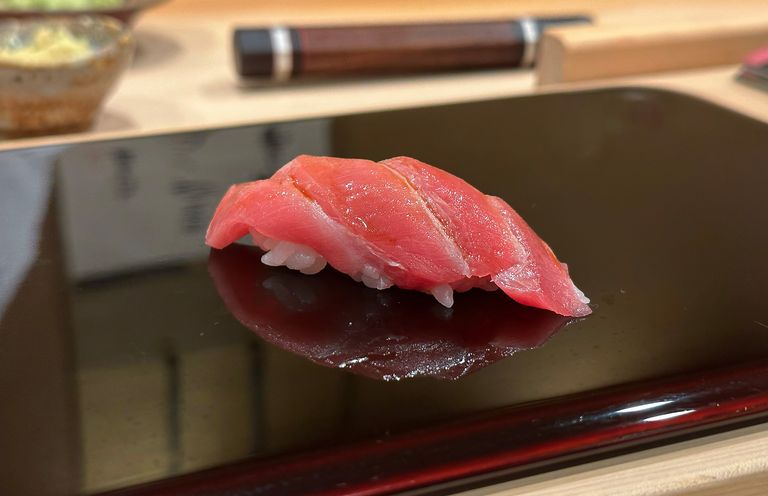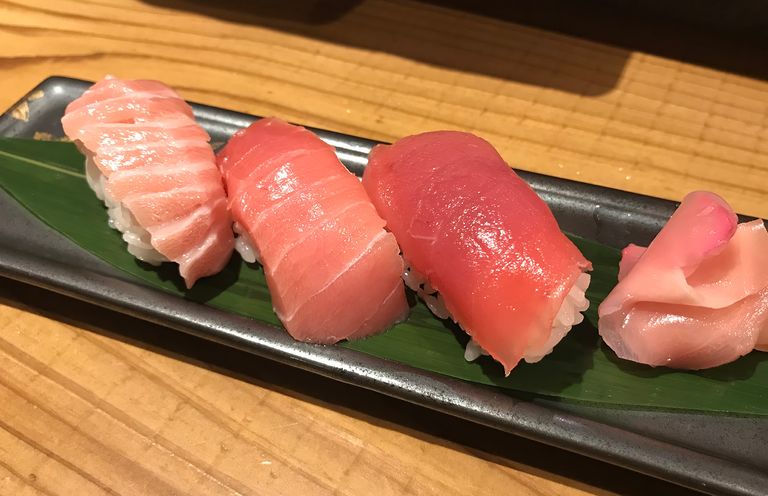Maguro Sushi
A Comprehensive Overview of True Tuna in Japanese Sushi Cuisine
マグロすし 、 鮪(黒漫魚・金鎗魚)寿司 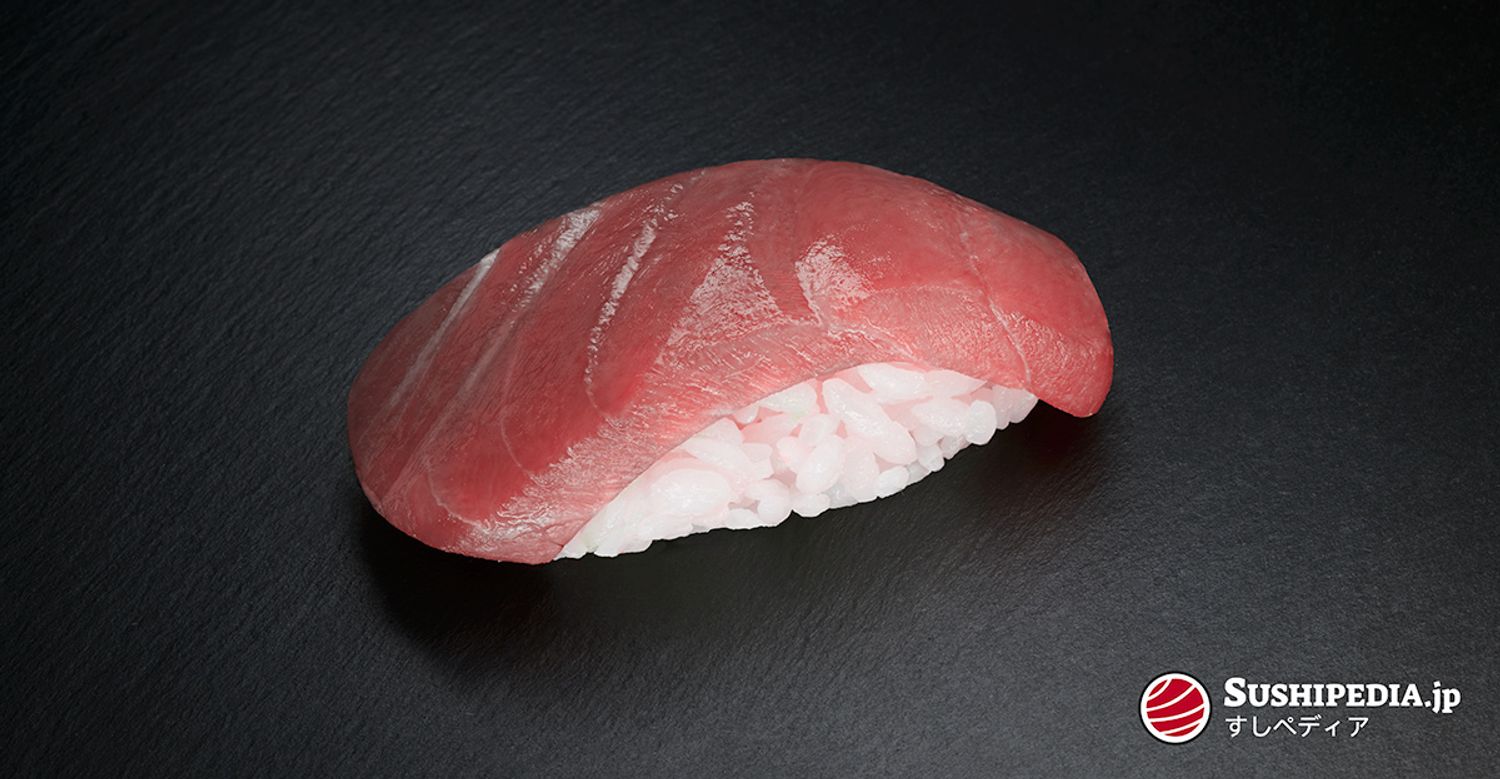
What is Maguro?
In Japanese, the term maguro 鮪 encompasses all species within the gbiological genus Thunnus, a taxonomic category that is also colloquially referred to as “true tuna”. The term “maguro” is a collective term for various species, regardless of specific distinctions such as species or region. However, its use depends on the context and requires more precise information. In premium culinary contexts, maguro commonly denotes bluefin tuna species, referred to as hon maguro 本鮪 in Japanese, where hon signifies “genuine” or “authentic.” This designation primarily encompasses the Pacific bluefin tuna (T. orientalis), the Atlantic bluefin tuna (T. thynnus), and the southern bluefin tuna (T. maccoyii). In addition to bluefin tuna, bigeye tuna (T. obesus), yellowfin tuna (T. albacares) and, to a lesser extent, albacore tuna (T. alalunga) are important for making sushi or sashimi. In Japan, bigeye tuna is mainly used for sashimi and sushi, as is yellowfin tuna, but its meat is softer, milder and less fatty, making it a cheaper alternative to other tuna species. Albacore, a commercially important tuna species, is used to a limited extent for sashimi and sushi.[1]
Furthermore, a distinction exists between imported tunas and those captured within Japanese territorial waters, referred to as kinkai maguro 近海鮪. The use of the term “maguro” for sushi or sashimi varies significantly according to culinary, economic, and logistical preferences. In general, the choice of tuna depends heavily on the gastronomic context: for example, the more affordably priced bigeye tuna is more often offerend in conveyor belt sushi restaurants, whereas bluefin tuna is encountered in upscale dining.
Maguro for Sushi or Sashimi
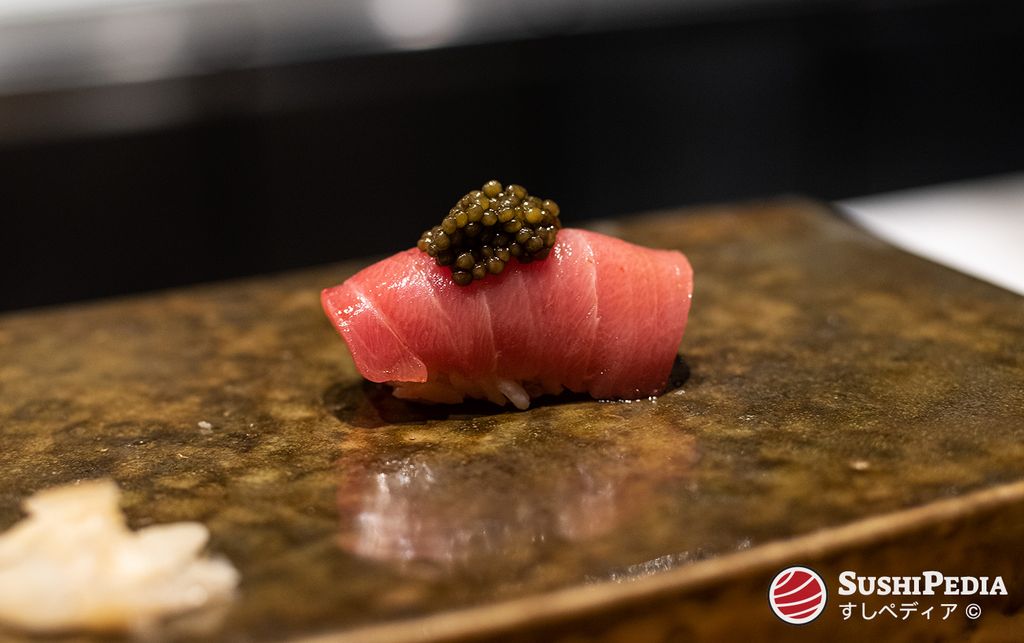
SushiPedia. Chutoro Bluefin Tuna Nigiri with Sturgeon Caviar. All rights reserved ©
The taste of maguro sushi or sashimi depends on the type of tuna used and which part of the body the meat comes from. In general, the meat is extremely tender and intensely flavorful. Meat that comes from the center of the body is dark red, shiny and very lean.
And shibi (adult bluefin tuna), good to make nigiri with and good to roll, is surely worthy to be called “the King of Sushi“
Jiro Ono, Sushi Chef (Sukiyabashi Jiro)[2]
In Japanese, it is known as akami 赤身. It has a subtly sour taste accompanied by full-bodied umami flavors. The texture is velvety and firm without being chewy. The fatty flesh of a maguro is called toro トロ, derived from torori とろり, which means “melting” or “creamy”. Symbolically, the term toro describes the sensation that literally melts in the mouth. Toro is mainly found on the belly and the back of a maguro. It is exceptionally tender, very rich in fat and has an intense, sweet, buttery taste that is unmistakable.
Aging Tuna for Sushi
Experienced itamae carefully preserve slices of maguro flesh, storing them for several days either in ice or under refrigeration. Through this aging process, known in Japanese as jukusei 熟成, the meat loses its intrinsic odor, thereby gaining in flavor and tenderness. The aging process for maguro is critically dependent on the fish's quality and condition, necessitating careful evaluation. Over-aging can result in the loss of the meat's vibrant color and a decrease in the firmness of sinewy layers (suji), particularly in the belly area, compromising the integrity of the fatty portions. Conversely, the texture and flavor of maguro that has not been properly aged, particularly with younger bluefin tunas (meji), may present a tougher texture and diminished flavor.
A study by the University of Tokyo in cooperation with the Japanese restaurant chain Kura Sushi confirmed that the taste of maguro intensifies when the meat is matured under controlled climatic conditions.[3] In upscale sushi restaurants, the aging process is individually adjusted according to the preferences of the itamae and the quality of the maguro meat, which can take up to several days to weeks. Mastering the aging process — and in particular the microbiological quality — of meat depends on controlling good hygiene practices and environmental conditions.
Best Season
The fat content of maguro depends on the season and its catch region. Specimens caught in cold sea regions, before the spawning season, have the highest fat content and are therefore most sought-after.
The best season for maguro, which comes from the North Pacific, is between September and January. During this time of the year, it stores more fat in his belly and back regions. Maguro from tropical waters spawns all year round and is therefore available through the year in varying quality. The best season for maguro from the Atlantic Ocean, caught in the Gulf of Mexico, is between January and April. For the East Atlantic stock of maguro the best season is October to April.
Maguro fattened in aquaculture facilities is available all year round in consistent quality.
From Kami to Shimo: The Sections of the Maguro
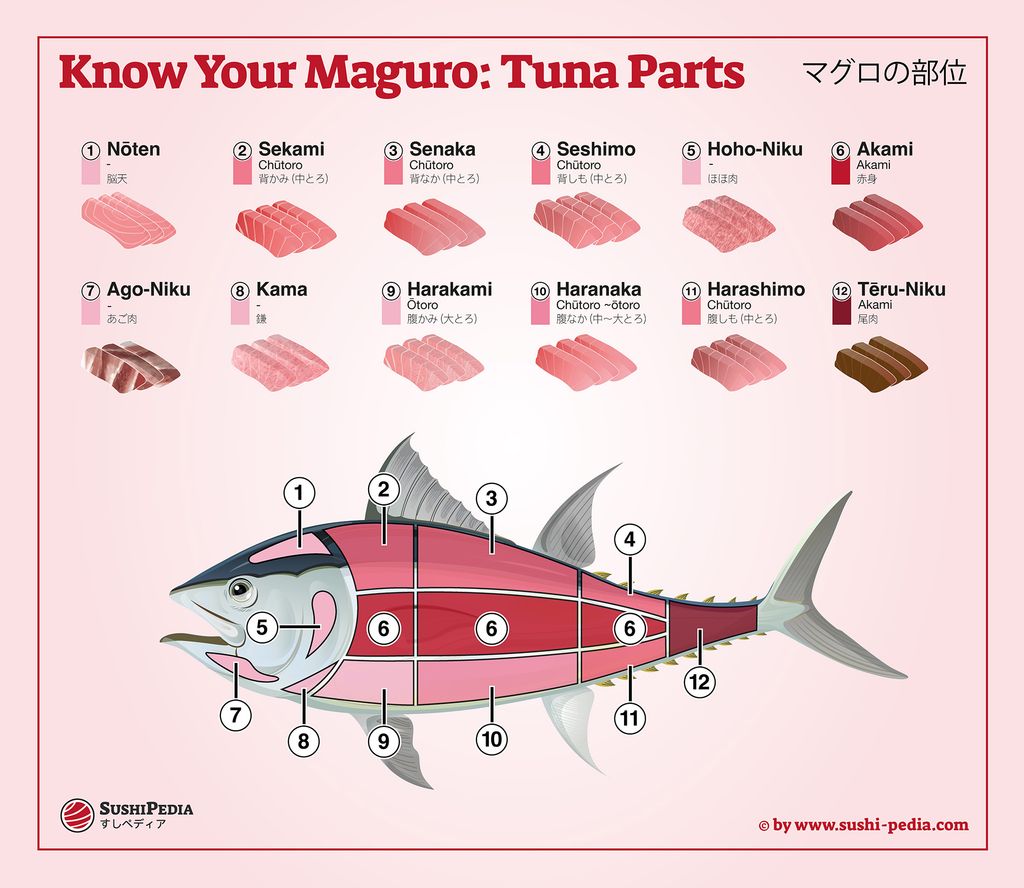
SushiPedia. Maguro Sushi - Know Your Tuna Meat Cuts · Sushipedia. All rights reserved ©
The meat of maguro can be divided into three sections:
- The frontmost section is called kami かみ
- The middle part is referred to as naka なか
- The rear region is named shimo しも
These three sections are subdivided into back (se せ) and stomach-part (hara はら). Furthermore, the forehead (noten のうてん) and gill or collar meat (kama toro かまトロ) can be used and are considered a special delicacy.
In the meat from the dorsal section, the strips (sinew or tendon plates) are thicker in the front region (kami) and thinner within the rear section (shimo). The middle section (naka) is the least streaked and accordingly higher in price. Meat from the region of the belly is fattier the closer it is to the gills. With increasing direction to the rear back section (shimo), the fat content decreases and therefore also the price.
Classification of Maguro Sushi

SushiPedia. Maguro Tuna Cross-section – Sushi Meat Quality Grades · Sushipedia. All rights reserved ©
The meat is divided into different categories according to its texture and fat content. This categorization is essential to understand the diverse taste experiences that maguro offers. Akami 赤身, the lean, dark red meat, is particularly popular for its firm texture and pure, intense flavor. In contrast to akami is toro トロ, the term for the fatty parts of the tuna, which are characterized by their buttery texture and intense, full-bodied taste. Toro is divided into ōtoro 大トロ, the very fatty belly meat, and chūtoro 中トロ, the part with a medium fat content. Chūtoro, with a medium fat content, offers a balance between tenderness and a full-bodied flavor. Ōtoro, on the other hand, known for its extremely high fat content and special marbling, is the most expensive variety and is prized for its melting texture and rich taste.
Akami: The Lean Meat
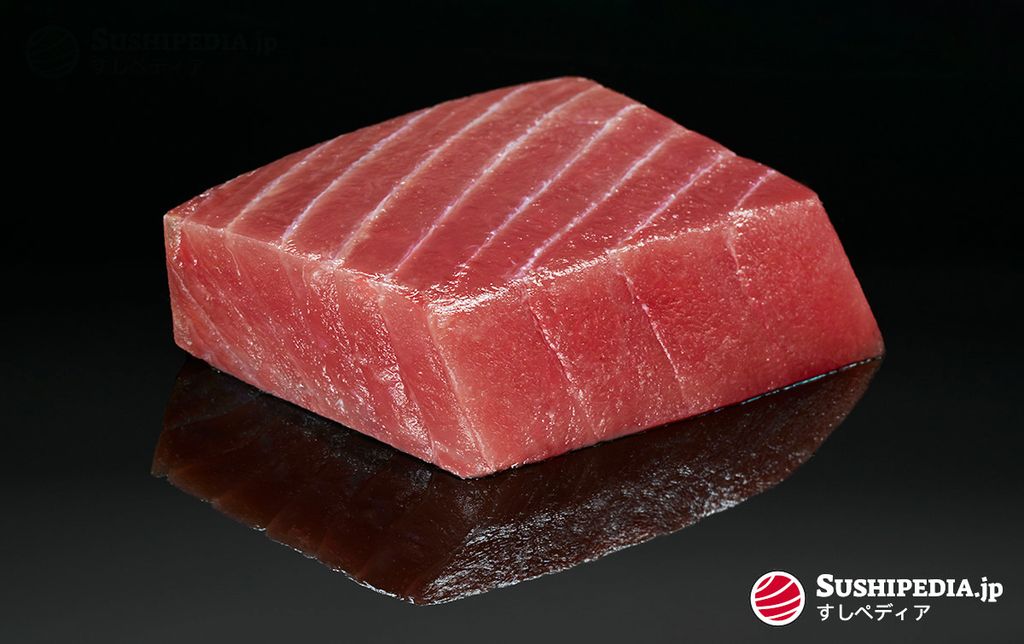
SushiPedia. Maguro Tuna Akami Saku – Perfect for Sushi · Sushipedia. All rights reserved ©
Meat from the center of the maguro is very low in fat and has a striking red color. Lean red meat is called akami 赤身 in Japanese. The average proportion of akami is about 60% of maguro and is cheaper than the fatty meat. The lean meat is rich in minerals, L- amino acids, and hemoglobin, which contain iron ions, giving the meat its subtle metallic taste, which are accompanied by a refreshing acidic flavors (sanmi 酸味). The term “akami” may not always appear on menus; typically, “maguro sushi” or “maguro sashimi” is used to denote the lean, reddish meat known as akami, particularly when no further distinction is being made.
The essence of maguro lives in the lean meat. Sushi lovers, eat your lean meat.
Jiro Ono paraphrasing food critics, Sushi Chef (Sukiyabashi Jiro)[2]
Akami from the middle region (naka なか) is particularly tender and is characterized by pronounced umami flavors. It is considered the highest quality akami meat by most chefs.[4]
Maguro Zuke: Marinated Tuna Meat

SushiPedia. Maguro Zuke Nigiri - Soy Sauce Marinated Tuna Sushi · Sushipedia. All rights reserved ©
Before the advent of modern refrigeration technology, tuna could only be transported over short distances. Without any kind of preservation, the tuna would have spoiled before reaching the cities. Therefore, tuna needed to be preserved by soaking the meat in soy sauce, called zuke no maguro 漬つけのマグロ or maguro zuke for short. For this purpose, the lean, reddish parts of tuna are utilized, as they absorb the sauce more effectively than the fatty parts due to their lesser hydrophobic properties.
The salt contained in the soy sauce and the exclusion of air have a positive effect on the shelf life of the meat. In addition, the sauce functions as a seasoning, because it is rich in amino acids and contains umami components. By soaking, the umami component is added to the meat or already contained umami components are strengthened. In addition, the texture changes, the meat becomes firmer and the surface at the same time more velvety. In addition to pure soy sauce, individual mixtures are used as desired, which still contain mirin and sake, for example. The pickling time depends on the personal taste, so that the range can extend from subtly mild to intensely salty.
Toku-jō no Akami: Meat of the Highest Quality
In the midsection of the tuna (naka なか), near the center of the body, where the vertebrae are located, there is a region known as the tenmi 天身be. The darker color and the triangular shape of the section are striking. The lean meat within this region is known as toku-jō no akami 特上の赤身 and represents the highest quality of lean meat. The Japanese term can be translated into English as “lean meat of the highest quality”. It tastes intensely of tuna and has little sinew. It has an intense tuna flavor and little sinew, making it a popular ingredient for nigiri sushi or sashimi due to its uniform dark color and velvety texture.
Chūtoro: The Semi-Fatty Meat
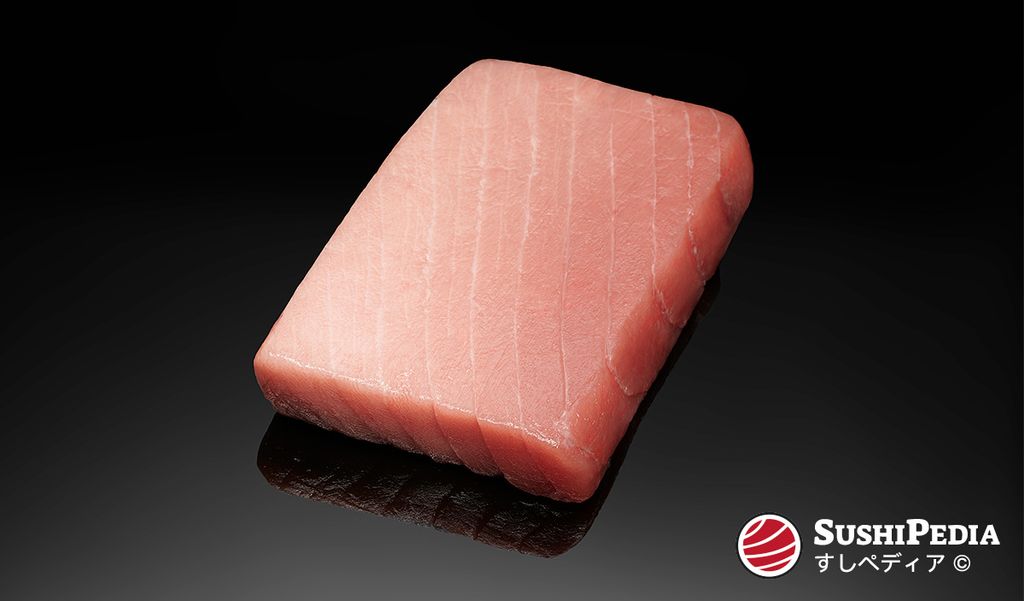
SushiPedia. Maguro Chutoro Saku – Premium Tuna for Sushi and Sashimi · Sushipedia. All rights reserved ©
Chūturo 中トロ is taken from parts of the back and abdomen of the maguro, it accounts for about 30% of the total quantity and is therefore priced between akami and otoro. The meat is extremely tender and has a slightly sweet buttery taste.
Enpitsu: Small and Delicate
If a hon maguro is particularly large and rich in fat, it is possible to separate a fine strip between the chūtoro meat and the skin. This elongated, narrow section is nicknamed “pencil”, on Japanese enpitsu えんぴつ. The piece called enpitsu is marbled, extremely tender and has a full-bodied taste. Sushi chef Jiro Ono lovingly describes it as the “King of Chūtoro”. Since tuna fish of special quality is needed for enpitsu, this cut is rarely available even in very high-quality sushi restaurants and is usually reserved for their regular customers.[2]
Hime: Tender, With a Special Texture
The middle region (senaka せなか) is considered to be of particularly high quality meat. Within this section, below the dorsal fin, is the one piece known as hime ひめ. This relatively small section is of special chūtoro quality. This special and relatively small piece of meat impresses with its particularly smooth texture, is free of sinew and less oily.
Hagashi: Tendon-free
In the middle area of the tuna, near the dorsal fin where the veins run along, there is a piece of meat known as hagashi はがし or wakaremi ワカレミ. This is also known as “streakless chūtoro” (suji-nashi no chūtoro 筋なしの中トロ) due to its texture without visible muscle strands. Hagashi, together with hime and enpitsu, is one of the most exquisite cuts of medium-fat tuna meat. It is prepared by carefully separating or cutting it into individual strips, which produces its exceptionally tender and soft texture. Due to its texture, this meat is particularly prized for nigiri sushi and is considered one of the most sought-after ingredients.
Toro: The fatty meat
In Japanese, toro トロ s the generic term for the fatty part of tuna meat. It is known for its soft texture and intense flavor. The word is derived from torori とろり and in Japanese describes a texture or consistency that is melt-in-the-mouth, soft or creamy. It is often used to characterize the texture of food that melts in the mouth, such as particularly fatty pieces of fish, creamy sauces or soft tofu. With regard to sushi, the quality refers to the fish meat, which is particularly tender and flavorful and leaves a melting sensation in the mouth. There are different quality levels based on fat content and texture.
Ōtoro 大トロ denotes the highest quality within the toro category and is the extremely fatty belly meat of tuna. Ōtoro is a particularly prized tuna variety due to its marbled texture, buttery soft texture and rich flavor. It is found in the front belly area of the tuna and is considered one of the most expensive varieties offered in sushi restaurants. While toro is a collective term for all fatty parts of the tuna, ōtoro represents the top of this category with the highest fat content and the best quality.
Negi-toro: Seperated Meat
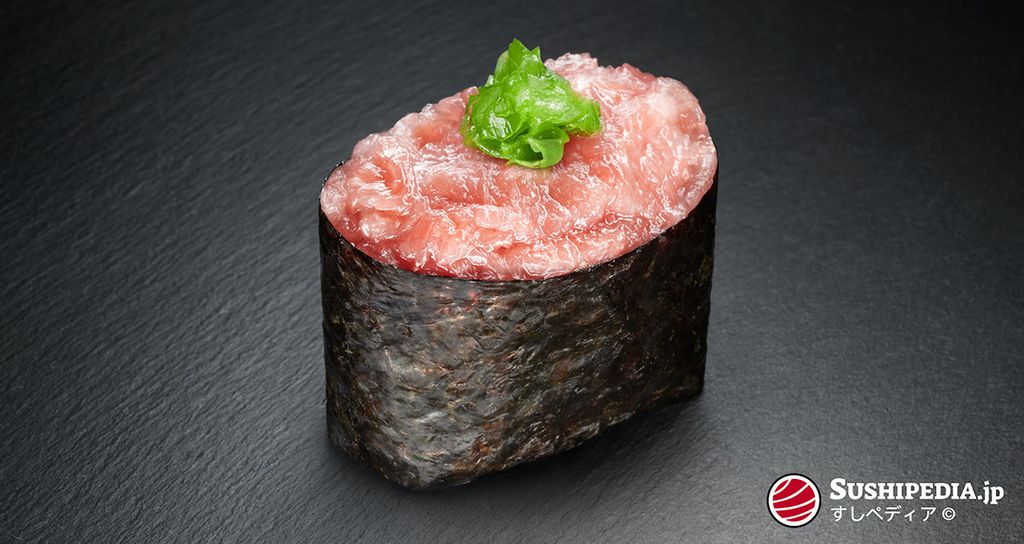
SushiPedia. Maguro Negi Toro Gunkan Maki – Classic Sushi · Sushipedia. All rights reserved ©
Negi-toro, derived from meticulously scraping tuna off the bones, skin, or directly from the flesh, represents a culinary practice aimed at utilizing the precious meat located in the interstices of fish bones. This method, emphasizing sustainability, ensures that the rich flavors of every part of the fish are preserved. Obtained either as nakaochi (from the bones), from the skin, or as sukimi (from the flesh itself), negi-toro is celebrated for its supremely tender texture that almost dissolves upon contact with the palate. This delicacy is frequently featured in sushi preparations, where its unique qualities are especially prized.
In more affordable dining establishments, like conveyor belt sushi restaurants (kaiten sushi 回転寿司), it is common to find ordinary lean meat that has been minced and combined with cooking oil or other additives as a substitute. True negi-toro stands out for its remarkable tenderness, featuring a creamy texture that dissolves effortlessly in the mouth, accompanied by a subtle sweetness. The crispiness of a nori leaf complements this exceptional softness perfectly, enhancing the overall sensory experience.
Kama Toro, Kamashita: From the Forehead
Kama toro 鎌トロ or kamashita かました is one of the most fat-marbled pieces of tuna meat. It is located in the lower part of the collar band of the maguro. It is a triangular-shaped region that is located under the gill cover and in front of the tuna's belly. Therefore, only two small pieces can be taken from a maguro at a time. Even with very large individuals, the proportion of total meat is well below 1%. The meat is heavily interspersed with oily connective tissue and tendon plates, but is still very tender due to its extreme fat content. It is by far the greasiest meat in tuna, and accordingly highly priced and sought-after.
It should be noted, however, that the meat is extraordinarily fatty. Occasionally, sushi chefs receive feedback that kama toro is too greasy for some customers.
Ōtoro: The Extra Fatty and Tender Belly Meat
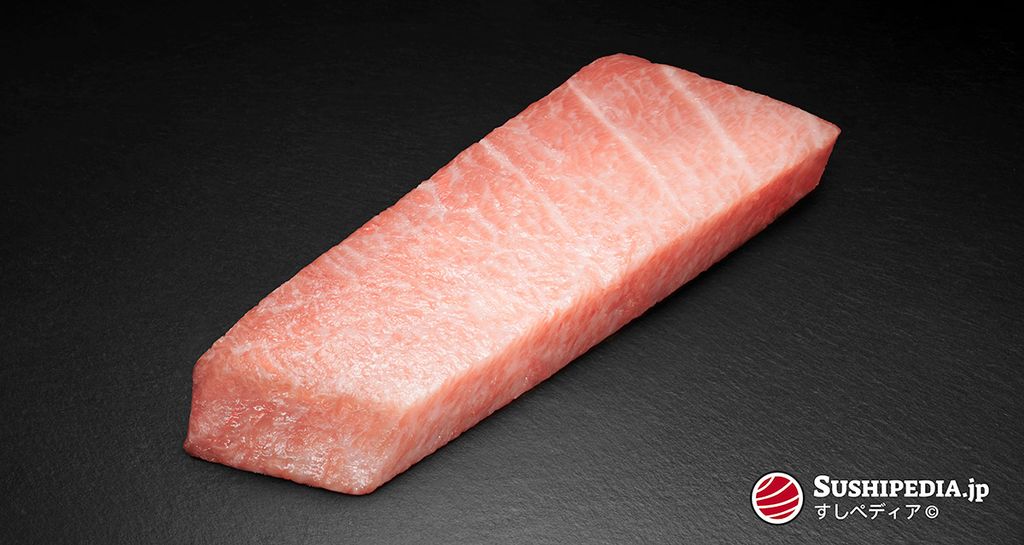
SushiPedia. Maguro Otoro Saku – Exclusive Tuna Piece for Sushi · Sushipedia. All rights reserved ©
The particularly fatty abdominal fat that envelops the organs of the maguro is called ōtoro 大トロ. In Japanese the character 大 means “physically large”, in the context of toro (“literally melts on the tongue”) it stands for “extreme” or “extra” and can be read as a long “o” (おお). So ōtoro is the part of the tuna that feels extremely soft on the tongue and melts away, thanks to its extreme fat content. The taste of the ōtoro meat is very different from the lean red meat.
It was not until the advent of modern refrigeration technology, a growing infrastructure and a prospering economy that maguro sushi took on the diverse characteristics we know today. Suddenly it became possible to introduce the fatty ōtoro parts that had previously spoiled too quickly.[4] Due to its high fat content, toro has a water-repellent effect (hydrophobic) and could not be at that time, as akami could. Until the postwar period, toro was considered a low-quality fish (gezakana 下魚) or pejoratively called neko matagi 猫またぎ, something even a cat would spurn.[5][6] [7]
Shimofuri: A Structure Like Snow
The foremost area of the harakami region is particularly noteworthy. At the tip, just below the gill cover, there is finely marbled ōtoro meat, which is known as shimofuri 霜降. The structure is reminiscent of snow, and the fine grain or marbling is similar to the meat of the highest quality Wagyu cattle.
Jabara, Haramo, Suanzuri: Sinewy, Yet Particularly Delicate
Besides the marbled shimofuri-ōtoro, the lower belly of the maguro contains meat called jabara 蛇腹, haramo ハラモ, or sunazuri すなずり. Of all the regions, it contains the most fat, but also the highest proportion of tendons. Due to the high proportion of tendons, the meat must be matured sufficiently, otherwise it is unpleasantly tough. When processed properly, sushi or sashimi made from jabara-ōtoro rewards you with an exceptionally sweet taste and a soft texture. The meat falls apart on the tongue with just a little pressure.
The meat from this region can also be processed like wakaremi or hagashi, in which it is finely peeled off or cut from the sinews layers. This skillful separation results in a distinctly delicious piece of ōtoro that delights in both flavor and texture.
Other Sections
Ago-Niku: Chin Meat
The chin meat of tuna is known as ago-niku あご肉. Tuna meat is characterized by its high gelatin content, elasticity and fat content. The taste differs significantly from other types of meat. Due to its firm consistency, it is not used raw, but is usually cured and grilled.
Nōten: Forehead Meat
Nōten 脳天 refers to the meat from the head or forehead of a tuna that makes up less than 1% of the entire fish. It is rumored that some fishmongers prefer to keep this part for themselves instead of selling it. Commercially available nōten usually has a moderate price compared to other fatty meats. The characteristic feature of nōten meat is its pattern of connective tissue, which, unlike the parallel patterns, is arranged concentrically. The fat content is comparable to that of chūtoro, and it has a firm elasticity. Some even claim that it tastes better than ōtoro.
In addition to the term “nōten”, this tuna meat can also be found under the terms hachi no mi 鉢の身、 tsuno-toro つのトロ、 hōniko 頬肉.
Hoho-Niku: Cheek Meat
Meat that comes from the cheeks of the tuna is called hoho-niku ほほ肉 in Japanese. Hoho-niku is generally used cooked as a side dish to other dishes. If it is used as an ingredient for sushi or sashimi, it is usually also cooked and not used raw, as is usually the case. The consistency is elastic and firm at the same time. The texture is fibrous, with a good balance of fat and red meat.
Tēru: Meat From the Caudal Peduncle
The area in front of the caudal fin of a fish is called the “caudal peduncle” (bihei 尾 柄). In a gastronomic context, it is less specifically called tēru テール, which translates as tail. The term is a transliteration from English into Japanese for the word “tail”. It is the area that connects the base of the tail fin to the rest of the body in tuna. It is relatively narrow in relation to the rest of the body, which enables efficient movement in the water. The caudal peduncle plays an important role in the swimming dynamics of the fish. It supports the transfer of power from the muscles to the caudal fin and helps the fish to move forward or change direction. Due to these muscles and tendons, the meat is rich in collagen, firm and very elastic. It is therefore not suitable for eating raw; it is much more recommended cooked, primarily in the form of a steak.
Maguro in Japan
In old and pre-industrial Japan, the only way to preserve the freshness of fish and seafood was to keep them alive in basins filled with seawater, but the body size of tuna made this impossible. Only by the emergence of soy sauce, maguro could experience a spread beyond the Japanese fishing villages. At this time, people began to preserve food by preserving it in a customized soy-alcohol sauce (zuke 漬), including the lean meat of maguro. With the invention and spread of industrial freezing, the fatty toro meat also found its way to Japanese consumers. Until then, toro was considered inferior and not very tasty. Only by the rise of other fatty foods did the dietary and taste habits of the Japanese change so much that the triumphal advance of toro took its course to its current, almost iconic position in sushi gastronomy.
The younger generation has grown up with hamburgers and meat […] They want fatty fish like salmon or fattened farmed bluefin tuna.
Yamamoto Takaichi, Misaki Tuna Auction Director[8]
Who travels to Japan today to find first-class bluefin tuna (hon-maguro) should go to Oma 大間町 in the prefecture of Momori. The tunas caught in the Tsugaru Strait 津軽海峡 off the coast of Oma have an almost legendary reputation in Japan. Tuna from Oma is a protected geographical indication in Japan, which is associated with a lot of prestige. Oma gained national attention when a bluefin tuna weighing 440 kg was landed there in 1994. Since then, “Oma Maguro” has been selling at record prices at auctions, such as in 2019, when a tuna was auctioned at the Tsukiji fish market in Tokyo for the equivalent of over 3,000,000 U.S. dollar.
Important centers of tuna fishing are in the prefecture of Shizuoka and Miyagi In addition to Oma, tuna from Sado and Kii-Katsuura also play a central role, especially in top gastronomy.
The Most Expensive Fish in the World

SushiPedia. Tuna auction at the Tsukiji market in Tokyo, Japan. All rights reserved ©
Until the 1960s, bluefin tuna was considered a fairly inexpensive fish. Initially fueled by the early upturn in the Japanese economy, this was followed by an explosion in demand due to the global triumph of sushi. This drove the price of bluefin tuna to unprecedented heights for the time. Prices rose by more than 270% in the period from the 1970s to the 1980s. According to the Japanese consumer price index 消費者物価指数, tuna of the simplest quality cost an average of 128 yen in 1970, but by 1980 the price had risen to 350 yen.
The price of maguro, especially hon-maguro (bluefin tuna), depends not only on the quality but also on the season, fishing region and whether the fish is farmed. Of all tunas, hon-maguro is the most expensive, because the number and quality of the caught fish is more influenced by climatic conditions than the quantity of fish ranched in fish farms. The meat of a farmed maguro can be more than half the price of a comparable specimen in the wild.
Every New Year's Day, the first auction of the year is held at the Tokyo Fish Market. The auction, which has become famous all over the world, is of no importance for the top gastronomy. It serves much more as an advertising and PR platform for large operators of sushi restaurant chains. The high prices that are achieved there every year do neither reflect the market price nor the quality of the auctioned fish. Among restaurant operators, it is associated with great prestige and status to participate and win. It is well known that a winning bid gets a global media coverage, especially when a new record price is called.
Classifying Maguro by Age and Size
Bluefin tuna (hon-maguro) has different names in Japanese depending on age and size:
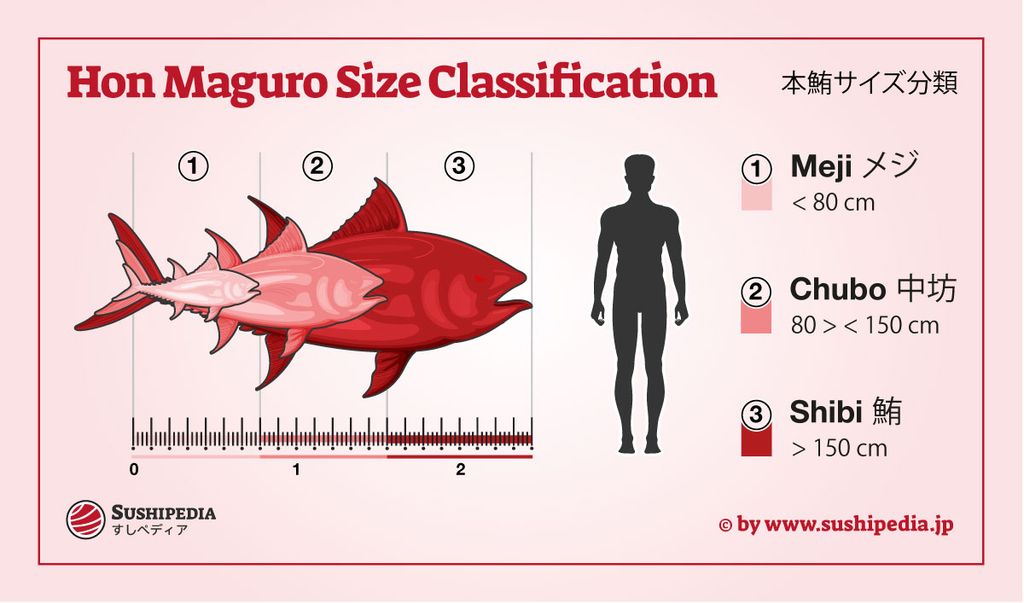
SushiPedia. Size Classifications of Hon Maguro Tuna. All rights reserved ©
Meji
The term meji めじ refers to very young bluefin tuna whose weight has not yet reached 10 kg. Scientific research shows that it takes up to 3 years for a bluefin tuna to reach the weight of 10 kg. The meat of a meji-maguro still lacks the distinctive red coloration and is more similar to that of bonito (katsuo 鰹). In summer, the young tunas are too lean, meaning that they are mostly used only in winter for the preparation of Sushi or Sashimi. In general, meji-maguro are significantly cheaper than older specimens.
Chubo
The character 中 is read as chū in the Japanese go- and kun-reading, and stands for “average” or “average” (neither good nor bad). The second character 坊 is understood as bō in the go-reading and means “boy” or “monk”. Accordingly, chūbō 中坊 is regarded as a tuna in the middle life cycle, which — metaphorically speaking — is similar to a monk who is still growing into the role of a priest.
In this stage of life a chūbō-maguro is up to 50 kg, has an approximate length of one and a half meters and an age of 3 to 5 years. The taste and fat content of a chubo-maguro is already more pronounced than that of a meji-maguro, but still does not come close to the quality of a big adult tuna.
Shibi
The Japanese character 鮪 is read in the kun-reading as maguro and shibi. Shibi is also the old Japanese term for tuna, and nowadays represents adult specimens. Shibi-maguro have reached sexual maturity, have an average length of about 2 meters and weigh about 170 kg. Tuna that are especially large and heavy are nicknamed “jumbo maguro” and can exceed a weight of 270 kg and reach an age over 20 years.
Characteristics and Ecology of Maguro
In addition to maguro, the term tsuna (ツナ) is also occasionally used for tuna. However, this rarely describes the genus of “true tuna” (genus Thunnus), but rather its super-group (tribe Thunnini), which also includes the true bonito and other species.
It should also be noted that although terms such as kajiki maguro 梶木鮪 (the colloquial name for swordfish) has the word “maguro” in its Japanese name, scientifically speaking it does not belong to the tuna genus. Names such as kajiki maguro or iso maguro 磯鮪 (Gymnosarda unicolor) are traditional names that existed before the establishment of science. They are historically evolved trivial names that arose due to external similarities or fishing-related traditions and are still used today.
Many tuna reach impressive speeds of up to 80 km/h (ca. 50 mph) thanks to their muscular and streamlined physique. Tuna are found in all tropical, subtropical and temperate seas. They have no swim bladder and must therefore be in constant motion, even when resting or sleeping. Tuna are highly migratory and travel several thousand kilometers a year in small schools during their migrations. All tuna are predatory hunters, feeding mainly on mackerel, sardines, and squid. Each population of a species prefers a fixed spawning area to which they return every year.
The largest tuna ever caught was a North Atlantic bluefin tuna weighing 678 kg and was landed in Port Hood, Canada in 1979.
Species of Maguro
Binnaga Maguro
The albacore tuna, also known as longfin tuna (T. alalunga), is a common tuna species worldwide and an important food fish. In Japanese, its common name is binnaga ビンナガ. It is characterized by its long fins and reaches a body length of up to 1.20 meters and a weight of up to 60 kilograms. This species can be found in the temperate to tropical waters of all oceans and in the Mediterranean. However, it is less common in the waters off Japan, especially in the Sea of Japan. As a predatory fish, it feeds mainly on other fish, crustaceans and squid. Its importance as a food source is also reflected in its processing into canned food, particularly in the form of canned tuna, which is regularly used in many households. The fatty part of the fish, known as bintoro びんとろ, is mainly offered in cheaper sushi restaurants.
Kihada Maguro
The yellowfin tuna (T. albacares), is a widespread species within the tuna family that belongs to the subgenus Neothunnus. Its range extends from the tropical and temperate waters of the Atlantic, Pacific and Indian Oceans. However, it is less common in the waters off Japan. Its name in Japan is kihada キハダ. Although the yellowfin tuna is mainly found in deeper sea zones, it can approach the coast if conditions are suitable. Its prey includes other fish, pelagic crustaceans and squid. Yellowfin tuna is an economically important fish that is used worldwide as an ingredient in everything from sushi and sashimi to tinned food.
Kuro Maguro
The North Pacific bluefin tuna (T. orientalis), also known as the kuro maguro クロマグロ in Japan, can reach a standard length of over 200 cm and a weight of over 450 kg. The largest specimen documented so far, off Kyūshū in 1986, had a length of around 3 m and a body mass of around 555 kg. The distribution area of the North Pacific bluefin tuna is mainly in the North Pacific, between Sakhalin Island and the south of the northern Philippines in the west to the Gulf of Alaska and Lower California in the east. Its habitat is the pelagic at depths of 0 to 550 m, but it is also found seasonally in near-shore areas. Of all tuna species, it migrates the furthest north and grows the largest. North Pacific bluefin tuna can reach an age of up to 15 years. In the wild, they mainly feed predatory on small schooling fish, crabs, and squid. In Japan, and also in some other countries around the world, it is considered to be the highest quality tuna in culinary terms. Nowadays, its meat is preferably used for raw consumption, such as sushi or sashimi, special traditional or gourmet dishes.
Koshinaga Maguro
The longtail tuna (T. tonggol), known as koshinaga コシナガ in Japan, is a relatively small tuna species that belongs to the subgenus Neothunnus. This species grows up to 145 centimeters long and weighs around 40 kilograms. Compared to similarly sized tuna, it grows more slowly and lives longer. Its range extends from the Indo-Pacific, especially near the coasts of the Arabian Peninsula, India, Japan, and Southeast Asia to Australia. The longtail tuna is a fish that lives mainly in the shallow waters of the near-shore shelf area. Like all tuna, the longtail tuna feeds on a wide range of smaller schooling fish, crustaceans, and squid. It is an opportunistic hunter. Although it is of great economic importance in its areas of distribution, in Japan it is relatively rarely used in the catering trade for sushi or sashimi. However, its flavor is considered good and it is sold at relatively low prices.
Mebachi Maguro
The bigeye tuna (T. obesus), is known as mebachi メバ in Japan. Like the other species in its genus, this species mainly feeds on smaller fish, crustaceans, and cephalopods. Its range extends from subtropical and tropical waters in the Atlantic, Pacific and Indian Oceans. However, this species is not native to the Mediterranean. Bigeye tuna generally live at greater depths than other tuna species. Their meat is therefore very fatty to protect them from the cold. The meat, especially the fatty part, is popular for preparing sushi or sashimi. Compared to bluefin tuna, the meat is significantly cheaper. In Japan, it is often found in supermarkets or cheap sushi restaurants.
Miminami Maguro
The southern bluefin tuna (T. maccoyii), whose Japanese name is minami maguro ミナミマグロ, is a species of tuna that is considered critically endangered. This species usually reaches a body length of 160 to 200 centimeters and weighs around 100 to 130 kilograms. The habitat of this species extends across the southern regions of the western Atlantic, the Indian Ocean and the Tasman Sea, along the 30th to 50th parallel. In contrast to the Pacific bluefin tuna and Atlantic bluefin tuna, which are mainly found in the Northern Hemisphere, the occurrence of this species is limited to the Southern Hemisphere. The southern bluefin tuna feeds on a variety of different fish species, as well as molluscs and crustaceans. The southern bluefin tuna, highly valued as an ingredient for sushi and sashimi, is particularly sought after due to its status as a delicacy. Limited catch volumes contribute to its premium pricing, and individual specimens of this species sometimes fetch high prices at auctions in Tokyo.
Taiseiyō Kuro Maguro
The Atlantic bluefin tuna (T. thynnus), also known as the northern bluefin tuna, is called taiseiyō kuro maguro タイセイヨウクロマグロ in Japanese. The name taiseiyō, which means “Atlantic”, is used to distinguish it from the North Pacific bluefin tuna, which is known as kuro maguro. Atlantic bluefin tuna inhabit the Atlantic Ocean, mainly north of the equator, as well as the Mediterranean Sea, the Caribbean Sea, the coast of South Africa and the Gulf of Mexico. The species reaches a common length of about 2 meters, the largest fish ever caught was 4.58 meters long and weighed 684 kilograms. The highest documented age of one is 32 years. The bluefin tuna lives pelagically and inhabits the open ocean from the surface to depths of 100 meters. Their diet consists of shoaling fish from the high seas and squid. The species is highly migratory, occasionally approaching coastal regions during its long migrations. They move in shoals, which consist of similarly sized individuals and are often associated with other tuna species. A large proportion of the bluefin tuna caught in the Mediterranean is exported to Japan and is characterized by its high quality.
Taiseiyō Maguro
The blackfin tuna (T. atlanticus) is a relatively small tuna species that belongs to the subgenus Neothunnus. Its Japanese name is taiseiyō maguro タイセイヨウマグロ, in contrast to other Japanese tuna names, this name is quite unspecific, as it simply translates as “Atlantic tuna”. The body span can reach a maximum length of just over 1 meter and a weight of 20 kg. The average length of the blackfin tuna is 72 cm, with a weight of 6 to 7 kg. This species prefers warmer waters in the tropical and subtropical areas of the western Atlantic, north to Massachusetts and south to Rio de Janeiro. It forms mixed shoals with the skipjack tuna (Katsuwonus pelamis), which is similar in size. They prey on fish, cephalopods and small crustaceans. The economic importance of this species is classified as moderate, although it is considered to be the least economically significant of the “true tuna” species. In Japan, blackfin tuna does not usually find its way into the import market, making its importance in the gastronomic context there irrelevant.
Economy of Maguro
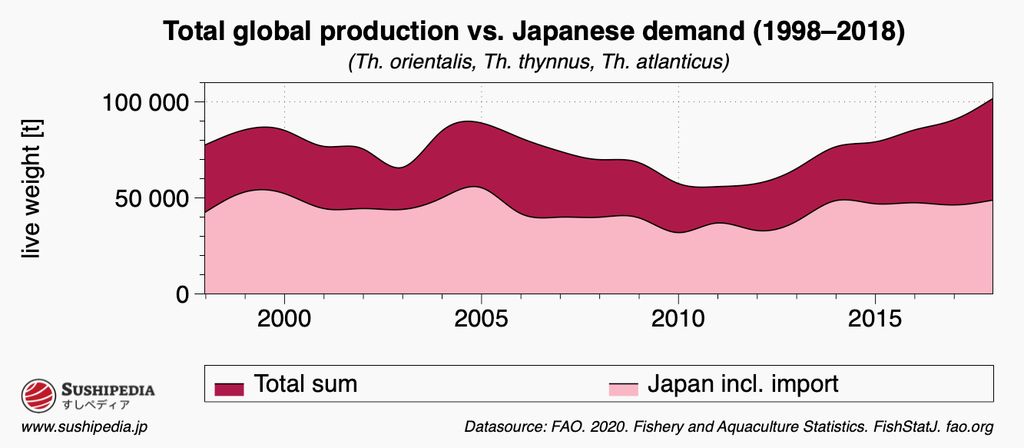
SushiPedia. Global Maguro Tuna Production vs. Japanese Demand. All rights reserved ©
Japan is the world's largest consumer and importer of bluefin tuna (hon-maguro), the majority of the world's catch is shipped to Japan to be served as sashimi and sushi. Main exporters of bluefin tuna to Japan are Australia and South Korea. Japan is not only one of the biggest importers but also one of the biggest fishing nations. According to the Food and Agriculture Organization of the United Nations (FAO), in 2018 Japan's share of the global catch of bluefin tuna was over 25%, putting it ahead of Australia (17%). Taking into account Japanese imports and catches, Japan claims well over half of the world supply of bluefin tuna (hon maguro). It can be seen that the Japanese demand for bluefin tuna is relatively constant.
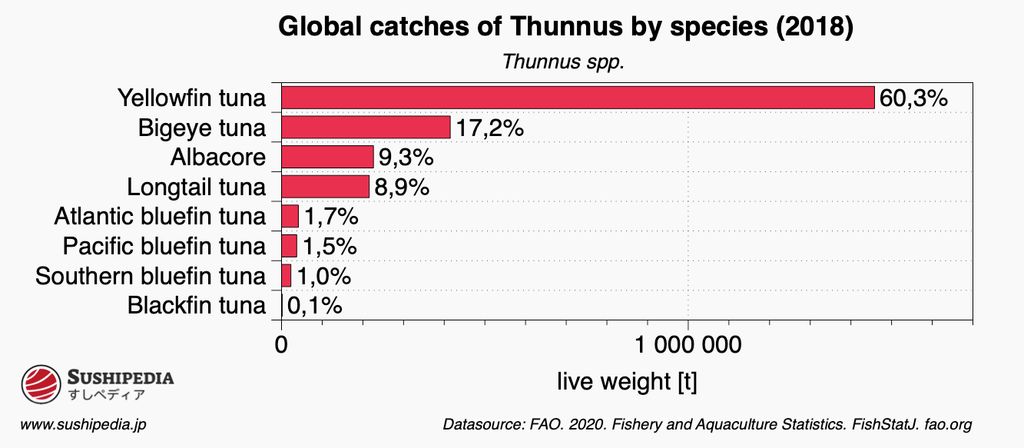
SushiPedia. Global Catches of Thunnus Tuna by Species. All rights reserved ©
The “maguro group” comprises eight species that differ in size, weight, and taste. Bluefin tuna is considered the most popular species for sushi and sashimi and is therefore sold at a high price. After that, yellowfin tuna (kihada キハダ) is the most popular ingredient for sushi and sashimi, especially outside Japan. In third place is bigeye tuna (mebachi メバチ), whose taste and quality is somewhere between kihada and hon maguro.
Overfishing
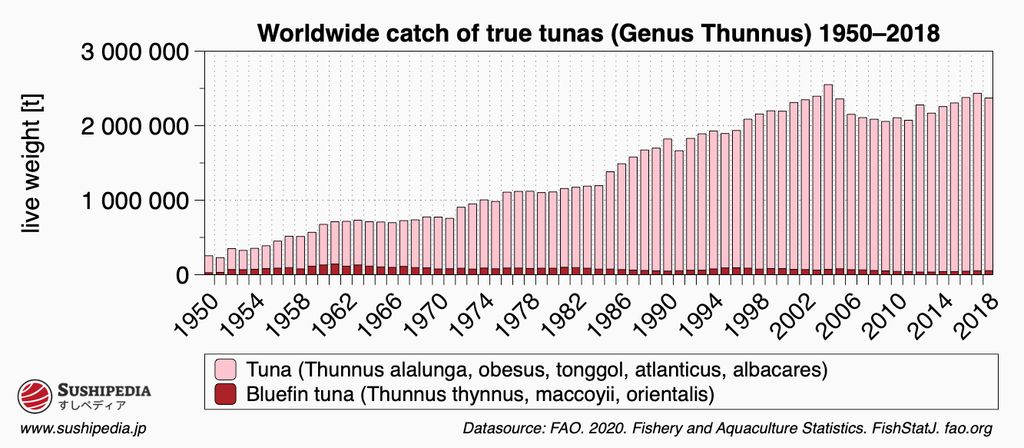
SushiPedia. Global Tuna Catch Volumes. All rights reserved ©
The growing demand, especially the global sushi trend and the resulting rise in prices have fuelled the overfishing of tuna around the world, making international resource conservation necessary.
Many tuna species are now facing serious threats that are endangering their populations worldwide. Overfishing is the main cause of the decline in stocks, as the high demand for tuna for human consumption, especially for the sushi and sashimi industry, has led to intensive fishing. This overfishing is exacerbated by illegal, unregulated and unreported fishing activities. In addition, habitat loss and marine pollution contribute to the endangerment of these species. The southern bluefin tuna (T. maccoyii) is already classified as critically endangered by the International Union for Conservation of Nature (IUCN). Referring to the IUCN, all three species of bluefin tuna are clearly overfished. Attempts to protect them were thwarted in recent years by representatives of national fishing interests. During the CITES convention in Doha in March 2010, Monaco and the European Union presented the proposal to ban the trade in bluefin tuna. Japan, Canada and several member states of the Arab League vehemently rejected the proposal. A subsequent vote on the proposal led to a clear rejection of the proposal with 20 votes in favor, 68 against and 30 abstentions.[9]
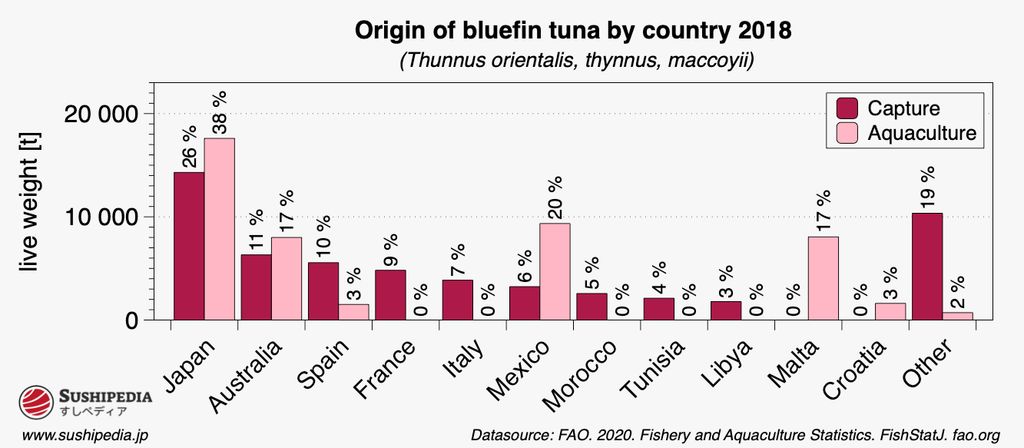
SushiPedia. Origin of Bluefin Tuna by Country. All rights reserved ©
Aquaculture
Tunas are generally considered difficult to cultivate because of their ecological requirements. Especially the expensive bluefin tuna, which is highly valued in the top gastronomy, is particularly difficult to raise in aquaculture because of its sensitivity to spawning conditions. In Japan, research on the breeding of bluefin tuna was started in the 1970s, but it was not until 2002 that the first breakthrough relevant to commercial farming was announced. The focus of the research is the commercially feasible complete aquaculture, in which in the long run no more fish have to be taken from natural populations. For more than 30 years, the Kindai University has been researching the breeding of bluefin tuna. In 2004 the first hon maguro bred from artificially fertilized eggs was shipped to the market. This is the first time the researchers have succeeded in creating a commercially viable breeding cycle. The Kindai University in Wakayama breeds and sells Pacific bluefin tuna under the brand name kindai-maguro. The breeding takes place mainly on the coast of Kushimoto in Wakayama Prefecture.
The aquaculture tuna currently in the market is almost exclusively bred using the “ranching method”. In this method, specimens are taken from the wild, transported to netted enclosures and fattened there throughout the year. Since no relevant differentiation between young and old animals is made in the selection of wild animals, a significant proportion of animals miss the chance to reproduce. This process is therefore a significant threat factor to global tuna stocks.
In aquaculture, maguro is mainly fed with sardines and mackerel and reaches a market size of around 100 kg within two years. Atlantic bluefin tuna (T. thynnus) in particular is fattened to market maturity in aquaculture within a period of three months to two years.[10][11] In contrast to their wild counterparts, aquacultured individuals tend to be smaller and have softer meat. However, controlled feeding practices allow for a consistently high body fat percentage, which increases the yield of toro, the highly prized fatty part of the fish. Although wild-caught tuna remains the pinnacle of taste and quality among sushi lovers, aquacultured maguro also offers a cheaper alternative for less affluent consumers.
Season Calendar for Maguro
The calendar shown does not provide information on fishing times, but marks the periods in which maguro is considered particularly tasty.
Video about Maguro Sushi
External video embedded from: youTube.com. Credit 江戸前寿司日ノ出茶屋 横浜. 高級本マグロ大トロ、中トロ、赤身すべて取れるハラナカのサク取り 〜How To Make Tuna Sushi〜.
Species of Maguro
The following species are regarded as authentic maguro. Either historically, according to the area of distribution or according to the common practice in today's gastronomy: The term maguro encompasses a variety of species that are grouped together under these names. Due to the extensive diversity of these species, it is not always possible to list all specific taxa in this list completely.
Sources and Further Reading
- [1]Vaclav Smil, Kazuhiko Kobayashi. Japan's Dietary Transition and Its Impacts. MIT Press. 2010
- [2]Shinzo Satomi. Sukiyabashi Jiro. Vertical Inc., New York. 2016
- [3]『マグロ、48時間熟成でうまみ増加 くら寿司と東大院 (48-Hour Aging of Tuna Increases Umami in Tuna, Kura Sushi and the University of Tokyo)』. Nikkei Inc., Tokyo (日本経済新聞社、東京都)、 2009-11-07. Source retrieved 12/26/2020
- [4]中原 一歩. 『「㐂寿司」のマグロは美しい。「㐂寿司」の365日。 (Tuna Sushi is beautiful. 365 days of Sushi.)』. dancyu.jp, President Inc., 2022-01-24. Source retrieved 1/1/2022
- [5]生田與克. 『たまらねぇ場所築地魚河岸 (I can't wait to go to Tsukiji Fish Market!)』. 学研教育出版 : 発売元学研マーケティング (Tōkyō : Gakken Kyōiku Shuppan : Hatsubaimoto Gakken Māketingu). 2010
- [6]知恵蔵. 『朝日現代用語 (Asahi Modern Terminology)』. 朝日新聞社. 1992
- [7]『東京人、第22巻 第1号』. 東京都文化振興会. 2007
- [8]Steven Adolf. Tuna Wars: Powers Around the Fish We Love to Conserve. Springer Nature Switzerland, Cham. 2019
- [9]Governments not ready for trade ban on bluefin tuna. Convention on International Trade in Endangered Species of Wild Fauna and Flora (CITES), Geneva, 2010-03-08. Source retrieved 12/26/2020
- [10]Vida Šimat, Jelena Vlahović, Barbara Soldo, Danijela Skroza, Ivica Ljubenkov, Ivana Generalić Mekinić. Production and Refinement of Omega-3 Rich Oils from Processing By-Products of Farmed Fish Species. Foods 8 (4). 2019. DOI: 10.3390/foods8040125.
- [11]Constantinos C. Mylonas, Fernando de la Gándara, Aldo Corriero, Antonio Belmonte Ríos. Atlantic Bluefin Tuna (Thunnus Thynnus) Farming and Fattening in the Mediterranean Sea. Reviews in Fisheries Science 18 (3) 266-280. 2010. DOI: 10.1080/10641262.2010.509520.
- Anthony Bergin, Marcus G. Haward. Japan's Tuna Fishing Industry: A Setting Sun Or New Dawn?. Nova Publishers, New York. 1996
- Caton A.E. (editor). Interactions of Pacific tuna fisheries Volume 2 Papers on biology and fisheries, Review of aspects of southern bluefin tuna biology, population and fisheries. In World meeting on stock assessments of bluefin tunas: strengths and weaknesses. Food and Agriculture Organization of the United Nations (FAO), Rome. 1994
- J. H. Farley, S. Ohshimo. Review and insights into the differences in reproductive parameter estimates between Eastern and Western Atlantic bluefin tunas stocks. ICCAT 75 (6) 1472-1493. 2019
- Karen Evans, Toby A. Patterson, Howard Reid, Shelton J. Harley. Reproductive Schedules in Southern Bluefin Tuna: Are Current Assumptions Appropriate?. PLOS One 7 (4). 2012
- Pinar Yerlιkaya, Nalan Gokoglu, Osman K Topuz, Mehmet Gokoglu. Changes in the proximate composition of bluefin tuna (Thunnus thynnus) reared in the cages located on the Gulf of Antalya (Turkey’s Western Mediterranean coast) during the fattening period. Aquaculture Research 40 (15) 1731-1734. 2009. DOI: 10.1111/j.1365-2109.2009.02276.x.
- Richard Ellis. Tuna: A Love Story. Knopf Doubleday Publishing Group, New York. 2008
- Roberto Cruz-Castán, Sámar Saber, David Macías, María José Gómez Vives, Gabriela Galindo-Cortes, Sergio Curiel-Ramirez, César Meiners-Mandujano. A possible new spawning area for Atlantic bluefin tuna (Thunnus thynnus): the first histologic evidence of reproductive activity in the southern Gulf of Mexico. Aquatic Biology. 2019
- S.C. Williams. The Japanese Tuna Markets: A Fundamentalists'v View. SPC/Fisheries 21/Information Paper 15. 1989
- Southern Bluefin Tuna Trade Data: Exploratory Analyses, CCSBT-CC/1209/1209/BGD 03. Commission for the Conservation of Southern Bluefin Tuna (CCSBT), Canberra. 2012. Source retrieved 12/26/2020
- An overview of the global tuna market. GLOBEFISH Highlights (4) 62. 2016
- Tamaki Shimose, Taiki Ishihara. A manual for age determination of Pacific bluefin tuna, Thunnus orientalis. Bulletin of Japan Fisheries Research and Education Agency 40 1-11. 2015
- Tamaki Shimose, Toshiyuki Tanabe, Kuo-Shu Chen, Chien-Chung Hsu. Age determination and growth of Pacific bluefin tuna, Thunnus orientalis, off Japan and Taiwan. Fisheries Research 100 (2) 134-139. 2009
- Yoshifumi Sawada, Toshio Kaga, Yasuo Agawa, Tomoki Honr Yo, Yang-su Kim, Masahiro Nakatani, Tokihiko Okada, Amado Cano, Daniel Margulies, Vernon Scholey. Growth Analysis in Artificially Hatched Pacific Bluefin Tuna. Aquaculture Science 61 (3) 315-319. 2013
- Yusuke Nagano, Ayaka Kibi. Bluefin tuna sells for low pandemic price at Toyosu’s 1st 2021 auction. asahi.com, The Asahi Shimbun Company, Tokyo, 2021-01-05. Source retrieved 1/6/2021
- 光敏 日比野. 『すしの歴史を訪ねる (Visit the History of Sushi)』. Iwanami Shoten (岩波書店), Tokyo (東京都). 1999
- 吉野 昇雄. 『鮓・鮨・すし―すしの事典 (Encyclopedia of Sushi)』. Asahiya Publishing (旭屋出版), Tokyo (東京都). 1990
- 堀武昭. 『マグロと日本人 (Tuna and the Japanese)』. Nihon Hōsō Shuppan Kyōkai, Tokyo. 1992
- 『消費者物価指数、年平均 1970~2019 (Consumer Price Index (CPI), Annual average 1970-2019)』. Statistics Bureau, Ministry of Internal Affairs and Communications (総務省 統計局). 2020. Source retrieved 12/26/2020
- 『知ってみよう すしのまぐろ | スシゴト | 回転寿司 スシロー (Let's get to know - Sushi no Maguro - Sushiro, conveyor belt sushi restaurant)』. Akindo Sushiro Co. Ltd., 2021. Source retrieved 1/1/2022
- The State of World Fisheries and Aquaculture (SOFIA), Sustainability in action 2020. Food and Agriculture Organization of the United Nations (FAO), Rome. 2020
- 美登世 土田、潤 髙橋、秀美 佐藤. 『すしのサイエンス:おいしさを作り出す理論と技術が見える (The Science of Sushi: Seeing the Theory and Technology Behind the Deliciousness of Sushi)』. Sibundo Shinkosha (誠文堂新光社), Tokyo (東京). 2020
- IUCN Red List of Threatened Species. Version 2023-1
Image Credits
- SushiPedia. Maguro Chutoro Saku – Premium Tuna for Sushi and Sashimi · Sushipedia. All rights reserved ©
- SushiPedia. Global Maguro Tuna Production vs. Japanese Demand. All rights reserved ©
- SushiPedia. Maguro Tuna Cross-section – Sushi Meat Quality Grades · Sushipedia. All rights reserved ©
- SushiPedia. Maguro Tuna Akami Saku – Perfect for Sushi · Sushipedia. All rights reserved ©
- SushiPedia. Global Tuna Catch Volumes. All rights reserved ©
- SushiPedia. Maguro Sushi. All rights reserved ©
- SushiPedia. Global Catches of Thunnus Tuna by Species. All rights reserved ©
- SushiPedia. Size Classifications of Hon Maguro Tuna. All rights reserved ©
- SushiPedia. Maguro Negi Toro Gunkan Maki – Classic Sushi · Sushipedia. All rights reserved ©
- SushiPedia. Maguro Otoro Saku – Exclusive Tuna Piece for Sushi · Sushipedia. All rights reserved ©
- Zheng Zhou. Maguro Otoro (fatty tuna) Nigiri. wikimedia.org. Some rights reserved: CC BY-SA 4.0 DEED, Attribution-ShareAlike 4.0 International. Changes applied: noise, crop
- SushiPedia. Tuna auction at the Tsukiji market in Tokyo, Japan. All rights reserved ©
- SushiPedia. Origin of Bluefin Tuna by Country. All rights reserved ©
- SushiPedia. Chutoro Bluefin Tuna Nigiri with Sturgeon Caviar. All rights reserved ©
- SushiPedia. Maguro Sushi Set @ Sushi Chiharu, 2019. All rights reserved ©
